Note
Have you guys thought of making a mobile app?
We’ve got one planned for development in 2021!
1 note
·
View note
Video
youtube
Build Characters From the Bottom Up - The Fundamental Aspects of Character
#authortube#writing#writeblr#writingadvice#writingtips#writingcommunity#writblr#creating a character#fanfiction#fiction writing#novelist#book writing#howtowriteabook#videoessay
0 notes
Video
tumblr
A character’s want and need are the fundamental aspects of your story’s plot and how your readers will experience it
#writingtips#writingadvice#writeblr#writing#fanfiction writing#writblr#writers on tumblr#author#campfirepro#campfireblaze#campfiretechnology#writer#novelist#screenwriting
0 notes
Video
tumblr
Understanding the relationship between want and need is crucial for creating interesting characters
#ironman#writing#characterdevelopment#fatalflaw#tonystark#want vs need#writingadvice#writingtips#writeblr#writblr#fanfiction#fanfic#fanfiction writing
0 notes
Video
tumblr
#character#writing#plot#writingadvice#writingtips#writeblr#CampfirePro#CampfireBlaze#thingsneedtohappenandpeopleneedtobetheretodothosethings
0 notes
Text
How to Craft a Character with Want and Need
Don’t feel like reading? Watch this blog instead!
Characters and plot are inextricably linked. You can’t REALLY have one without the other. They take up the same space. If a story has no characters, then nothing happens and there’s no actual story. If a story has no plot, then again nothing moves, nothing happens. No story.
The link goes even deeper than “things need to happen and there need to be people to do those things.” How you characterize the people in your story, will affect the plot, and in turn, the plot will affect the people in your story. This is because the main characters in a story require two fundamental things: Wants and Needs.
Want
What your main character wants is the most fundamental piece of creating a story. A character’s want is what propels stories forward. Why should a hero leave the comfort of their regular life if they don’t want anything? This fundamental piece of your character is the origin of the plot.
In the 2008 movie Iron Man, Tony Stark wants to atone for his sins as an arms dealer. That want propels the rest of the movie as he becomes Iron Man to help reduce the damage his company has done.
This relationship between want and plot is exemplified in this quote from Aaron Sorkin’s Masterclass.
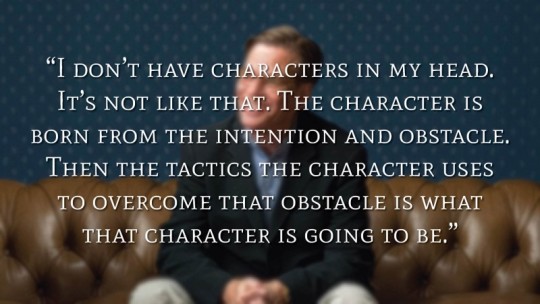
Obstacle
We have established a want, but something stands in their way. Now the character must decide what to do in the face of resistance. It’s these moments in a story where character is revealed the most. The choices we make here will precipitate the other aspects of their character like personality and backstory.
Imagine I’m writing Iron Man. I start with the fundamental want: Tony wants to fix the problems he’s caused. Now I have to decide how Tony responds to this. What stands in his way? The people who use his weapons, so I say he funnels his money into becoming a superhero. We have a plot to match our character’s want.

Now I can think about what that says about him. What are some character traits that align with that response?
Tony could be confident, rich, potentially egotistical, helpful, powerful, there are tons of different traits I could choose from. Obviously he is rich because he has to pay for the suit. He is confident in his ability to accomplish his task, but he is also confident to the point of being egotistical.
We can take these traits and turn them into concrete character detail. Tony is a playboy who likes to drink and hang around beautiful women. He is obsessed with expensive cars. He’s rude, but also kind of charming. All of these details are fundamentally driven by how the character chooses to respond to their want.
Need
Tony’s want isn’t just about helping others though. It’s about making himself feel better. It is about how he is coming to terms with his guilt, and that’s his fundamental flaw. His ego stands in the way of really helping people and atoning for his sins. The opposition between Tony’s flaw and his want is our next fundamental aspect of character: Need.
Tony needs to transcend his ego to get what he wants. This is an issue we will see play out in just about every movie with Iron Man in it, but we see it’s beginnings here.
The character’s need isn’t as concrete as their want. They often aren’t aware of their need, or are choosing to ignore it in Tony’s case. We watch Tony struggle with terrorists, the US Government, and his own company as he tries to fulfill his want, but what he needs is to be humbled. He needs to lose his ego.

Image via Marvel Studios
We can see this need fulfilled in the last fight of the movie where Iron Man must fight Obadiah who wants to weaponize arc reactor technology, a direct obstacle to what Tony wants. On the brink of losing the fight and therefore his want, Tony decides to make the ultimate sacrifice. He tells Pepper to crank up the arc reactor to take Obadiah out. This will also kill Tony. In this moment, his need is realized. He has shed his ego for the greater good.
That’s the theme of the story. Overcoming ego to help people. That’s the theme of Tony Stark’s entire character. The main character’s need is the theme of the story. It’s what the story is trying to say and is the emotional tether that connects us to the characters. Tony Stark isn’t the only one who has had to overcome his ego, that’s a universal struggle the audience can connect to.
Want and need are the two most important parts of a character. A character’s want defines the plot. How they respond to obstacles is what defines their characteristics, and their characteristics will define what they truly need.
These are the fundamental pieces to making a character that pulls in an audience and informs them about the human condition.
TL;DR: Character’s start with a want. How they react to something in the way of that want will decide their characteristics, and one of those characteristics will become their fundamental flaw.
If you have any questions or comments, join the discussion on our Discord!
#writing#ironman#want vs need#character development#character wants#character needs#video essay#writer#writeblr#writblr#plssubscribetoouryoutubechannelsoicanfeedmychildakamydog
0 notes
Text
Reading Joseph Campbell Will Help Your Writing
See how your story fits the Hero’s Journey structure using this Campfire Pro Hero’s Journey template file.
If you have been writing for a while, you may have heard about the hero’s journey and the monomyth. These are concepts that have worked their way to the core of modern storytelling. Nearly every blockbuster movie you see has its roots in the Hero’s Journey. Hollywood beat sheets are generally page by page guides that follow the journey’s steps.
The monomyth tells the story of a hero who must leave their normal world, venture out, and make grand sacrifices to achieve their goals. You can see this rhythm play out in modern and ancient stories, religions, and myths. It speaks to the human condition. It tells us how to deal with the losses and triumphs of life and come to terms with the world around us. Joseph Campbell was the first one to bring this rhythm to the public eye, and reading his work can help us understand how we can make our stories resonate with readers.
Who was he?
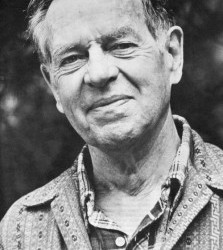
Joseph Campbell was a comparative mythologist in the 20th Century and a professor at Sarah Lawrence College for almost four decades. He was a child of the depression and was a young adult when the market crash hit. He told stories about how during the Depression he spent most of his time rooting around New York City reading books. It was then that he began to formulate his ideas about the Hero’s Journey.
He read everything from modern literature like James Joyce’s Ulysses to the ancient myths of long-dead civilizations. He found a rhythm running through almost everything he read. He realized that they all followed the same core structure and incorporated similar motifs and symbols. Eventually, he named this structure the Monomyth, or Hero’s Journey. After becoming a professor, his first solo work, The Hero with a Thousand Faces, would become the first major public introduction of this idea to the public.
What is the Hero’s Journey?
The Hero’s Journey is a series of story beats that make up “questing” stories. We have a hero that wants or needs something and has to go get it. For example, in Star Wars, Luke wants freedom. He wants to leave the farm and explore the universe. His desire for freedom and adventure thrusts Luke onto his epic quest.

Questing stories tend to make up the majority of stories that we tell. A hero’s need or want to find something is what drives the plot. Without a need, there is no plot.
Campbell describes this structure in detail in his book, The Hero with a Thousand Faces.
The Hero with a Thousand Faces
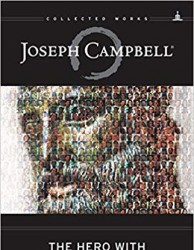
This book is dense. Campbell was a professor in the 1900s, and it shows. While the book is filled with amazing insight, you may get lost quickly just diving in. Here is a guide to help you navigate it.
The prologue of the book is about dreams and psychology. It addresses where Campbell thinks the Hero’s Journey comes from in the human psyche. He makes an argument that this process of adventure and self-sacrifice works so well because it speaks to something fundamental to all of us: change.
All stories are about change. If nothing changed, there wouldn’t be any stories. Humans are all too familiar with the pain of change from political to personal. Change brings challenges to conquer, and stories tell us how to face them over and over again.
Part 1: The Adventure of the Hero is where Campbell explicitly outlines the 17 steps of the Hero’s Journey. He discusses the motifs of all stories and how they are used around the world. They are broken into three fundamental parts: Departure, Initiation, and Return.
The departure is the exposition of the story. Here we meet the hero and see their call to adventure. Often the hero refuses the call and retreats to the comfort of normal life. They may be visited by a wise mentor who gives them a useful tool (think Obi-wan and the lightsaber). Finally, the hero chooses to leave the comfort of their known world and cross the threshold into the world of adventure.
The initiation is the bulk of the journey. This is where the hero is tested with trials as they venture into the unknown. They must grow to meet their task. Here the adventurer will find what it is they truly need, but then must take their newfound weapon back to the normal world for the benefit of all. Luke trains in the force, but then must bring it back to destroy the Death Star.
The return contains the final test. Things often go wrong here. The hero’s predicament seems worse than ever, and the hero resists the return, wanting instead to stay in the new world that they have mastered. However, they eventually pull themselves out of the gutter and bring the treasure back to the normal world, completing the quest.
Many of these steps have a metaphorical component. Sometimes the hero doesn’t bring back a physical treasure, but perhaps knowledge or maturity. Campbell explains how these metaphorical steps are used and how they serve our stories.
Part 2: The Cosmogonic Cycle is much more focused on the symbols and functions of mythology. The book becomes even denser here but is still filled with valuable information. Campbell has a lot of ideas about psychology and spirituality here in defense of the Hero’s Journey. This is perhaps less useful to writers than the rest of the book, but for those interested in mythology, it is a treasure trove of information.
The Power of Myth
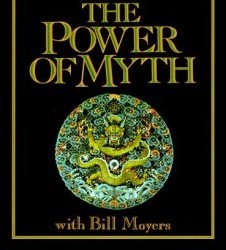
Other than The Hero with a Thousand Faces, The Power of Myth stands as one of Joseph Campbell’s most popular works. While it isn’t a book published by Campbell himself, The Power of Myth is a series of interviews with Campbell and Bill Moyers recorded at Skywalker Ranch. They aired on PBS and the transcripts were published.
These interviews stand as an excellent introduction to Campbell’s work. They contain an overview of the Hero’s Journey as well as Campbell’s ideas about symbol and myth. You can buy the DVD’s or view large portions of the interviews on YouTube. Text copies can also be found at a reasonable price. My local second-hand book store always has a couple of copies for less than five dollars.
I think this book is so important for writers that I have bought several copies and given them to friends. You should give it a read. It changed the way I look at storytelling.
Common Questions
Isn’t this unoriginal writing? I remember getting an introduction to the Hero’s Journey in high school, and simultaneously everybody in my class immediately bounced off the idea. “There is no way we are all telling the same story. I have original ideas!” This is a genuine concern, but the Hero’s Journey is not as restricting as it may seem. The metaphorical steps allow for lots of play. Not every hero’s “Call to Adventure” is the same, but every hero has one.
Community and Rick and Morty creator Dan Harmon talked about this in a 2015 episode of Pete Homles’s podcast, You Made It Weird. Harmon talks about how he was initially skeptical of the Hero’s Journey because it seemed like it would make him unoriginal.
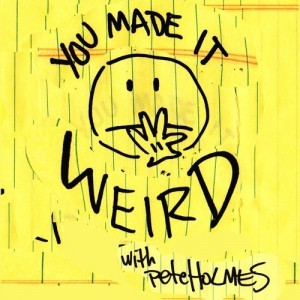
He then says that after seeing a video of Campbell speaking, it immediately became clear that it would not make him a hack. Rather, Campbell’s work evoked a truth that lies in all storytelling, and the new knowledge would help Harmon to finish and sell his first screenplay, Monster House.
Does every story really follow this? No…kinda? The Hero’s Journey provides a well-trodden path that works, and Campbell would say it works because it reflects the human condition. That being said, not all stories fit the mold perfectly.
For example, Pulp Fiction. This series of vignettes and non-linear storytelling does not clearly follow the journey, but many of the characters in the story follow their own mini-versions. Sam Jackson’s character is one of the many heroes of the story. He starts as a gangster and becomes a regular citizen by the end. This is a heroic transition.
How do I implement these ideas in my work? When you are writing and ask the question “What happens next?” That’s the time to break out Campbell. What the next step of the journey? It will give you a place to start. It also helps to outline stories in the building phases. It provides a clear path for your hero to accomplish their goals.
Campbell’s work and the Hero’s Journey is a lot to process, but it is invaluable knowledge for writers. It will powerfully change the way you tell stories. The Hero’s Journey provides a time tested outline for your stories that will help you engage with readers on a primitive level.
Weekly TLDR: Joseph Campbell was a comparative mythologist in the 20th Century. His work proposes the Hero’s Journey. The journey is a series of story beats in almost every story from The Odyssey to Star Wars. Learning these steps can help us craft better stories.
Don’t forget to see how your story fits the Hero’s Journey structure using this Campfire Pro Hero’s Journey template file. If you have any questions or comments, join the discussion on our Discord!
#josephcampbell#hero's journey#hero'sjourney#writing#hero with a thousand faces#monomyth#cosmogeniccycle#thepowerofmyth#writer#writeblr#writblr#writingcommunity
0 notes
Text
A Practical Guide to Actually Writing Your Rough Draft
So you want to write a book.
Welcome to the club. In this guide, I’m going to do my best to define a concrete, executable plan to actually write a fiction novel. If you follow this guide to the T, you will produce an 80,000- to 100,000-word rough draft in 4 months.
If that sounds appealing to you, then you’re in the right place. Let’s get started.
Phase 1: Get Organized (1 Week)
Writing a book is not an easy task. You’re looking at 80,000 to 100,000 words – for simplicity let’s assume 80,000. If you write 1,000 words per day, that’s an 80-day undertaking. And that doesn’t allocate any time for planning.
What all this actually means is that if you’re serious about producing a novel efficiently, you need to get organized. Specifically, you need to organize your story information – characters, plot outlines, worldbuilding notes, etc – and your manuscript – the actual document that contains your novel.
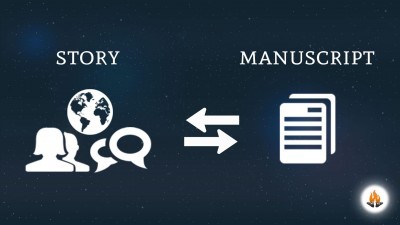
You should spend your first week getting comfortable with a system to organize this information.
Story Information
You may be tempted to dive right into the writing part. This a bad idea unless you really know what you’re doing. To start, you’ll want to establish a system of keeping track of little bits of information about your story. This can be everything from character traits and backstories to extensive lore about the story’s setting.
Luckily, there are a variety of tools available to help you with this sort of organization, both free and paid. Here are a few, sorted from least structured to most structured:
A Plain Old Document – This could be in the form of a Google Doc, Microsoft Word document, etc. If you go this route, I’d suggest organizing it under the following headers: characters, world, and plot. However, this method isn’t quite as organized as the options below, so read on.
Spreadsheets – This involves using Google Sheets, Microsoft Excel, or smarter spreadsheets like AirTable to store information. This method is a little more structured. For example, you could have a spreadsheet for your characters, with each row corresponding to one character, and each column corresponding to an attribute like “eye color”, “height”, or “backstory”. Then, whenever you need one of those details, you can just search for the character in the spreadsheet and navigate to the correct column.
Story Planning Software – There are software programs designed specifically for keeping track of story information. We suggest Campfire Pro, the writing software that we make here at Campfire Technology. It’s certainly not necessary to follow along with this guide and write your first book, but it’s worth checking out if you want to get organized!
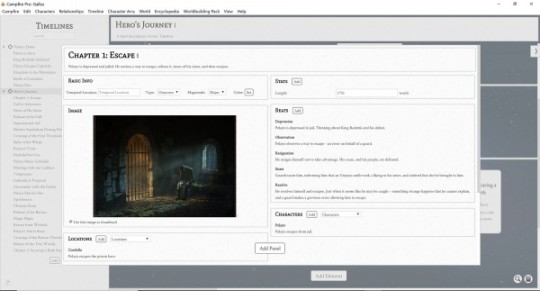
Campfire Pro’s Timeline View
The particular system you choose isn’t all that important – what matters is that you find one that works for you and you stick to it throughout the writing process. You’ll want to continually update it as you write so it’s always there as an aid when you get stuck or forget a key detail.
Manuscript
You’ll need somewhere to actually write your manuscript. There are a lot of options in this area as well, also ranging from free to paid.
For the simplest free manuscript editor, check out Google Docs. It has everything you need to write your novel, though people do say it can struggle a bit on slower computers with really long documents. For a more robust solution, check out Microsoft Word. Both of these options include a sidebar in the document that can show all your chapter titles so you can easily navigate between them.
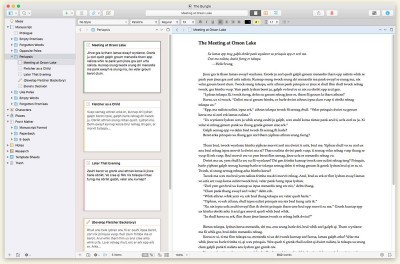
Scrivener’s manuscript editor
Finally, I’d be remiss to ignore Scrivener, a desktop application for writing books that offers the ability to reorganize entire chapters by just dragging and dropping – something that neither Word nor Google Docs can do. It’s a very common choice for organizing manuscripts.
Once you’ve chosen your system of organizing the story information and manuscript, you’re ready to move on to the next step.
Phase 2: Plan (1-3 Weeks)
Writers differ immensely in how much they plan before sitting down to actually write the manuscript. Some, like Stephen King, prefer to do very little planning. These folks are affectionately referred to as Pantsers – they like to fly by the seat of their pants with their writing. Others, like Brandon Sanderson, are architects who plan out in great detail how the story will unfold. These writers are called Plotters.
There have been brilliant writers of both kinds. However, we strongly recommend that every writer do at least a little bit of planning. Specifically, you should develop the story seed.
The story seed consists of three elements: a character, a place, and a predicament.
The character is the main character of your story. You don’t need a ton of detail here, but you should aim to have a rough idea of who your main character is. If you’re stuck, try to establish some backstory, a few personality traits, and some physical attributes.
The place is where your story takes place (or for Pantsers, where it begins). Again, aim for at a minimum a rough understanding of the setting – is it the modern United States, a medieval village, a galaxy far far away, or somewhere else entirely?
Finally, the predicament is what happens to the character in the place. If you’re a Pantser, then this predicament should probably occur at the beginning of the book – what happens to the character that kicks off the action? If you’re a Plotter, it should be the more overarching conflict that the entire book is about.
Here’s an example of a story seed for a Pantser:
A 10-year-old orphan in London discovers that he is a wizard.
Here’s the same story seed but for a Plotter:
A 10-year-old orphan in London must stop the return of the most powerful Dark Wizard of all time.
You should be able to develop this story seed in one week. Then, if you’re a hardcore Panster and you’re about to explode because of how much you hate planning, you can move on to Phase Three. That basic story seed is all you need to get started. If you’re a Plotter like me, you might want to spend as much as another two weeks planning. Read on.
Detailed Plotting
For a Plotter, the story seed does not represent a snapshot of the beginning of the story, but rather a summary of the story as a whole. As such, your predicament should refer to the major conflict that your character overcomes in the story. In Harry Potter and the Sorcerer’s Stone, the predicament is Lord Voldemort’s attempted return to power.
Once you have that predicament, you have a lot of plot to fill in. There are a few different structures you can use to help with this. The three-act structure provides a set of scenes or “story beats” that should occur on the way to the final conflict. The Hero’s Journey and Save the Cat provide similar frameworks. Learn about these, and then either choose one, merge them into your own framework, or ignore them all!
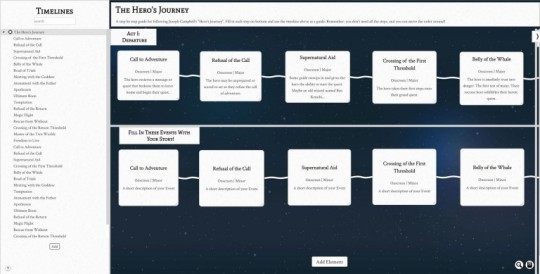
The Hero’s Journey in Campfire Pro
With any luck, the characters, plot, and world of your story will develop in parallel as you plan. For example, a decision about a character trait should influence what that character does (the plot). Similarly, a decision about the world could inspire part of a character’s backstory. If you feel stuck, just pick one aspect of the story and start adding detail – the rest will flow from there. Just make sure you’re keeping track of all the decisions you make using your organizational system. Fill in those spreadsheets!
As a Plotter, the end goal of all this planning is a book outline. If you’re writing an 80,000-word book, that means you need perhaps 10-25 chapters with word counts varying from 3,000 to 8,000 words. How you decide to break it up will depend on your writing style and your story – but you should aim to have an outline containing what happens in each chapter and an estimated word count.
Now, Pantsers and Plotters, is the moment you’ve all been waiting for.
Phase 3: Write (12-14 Weeks)
Finally, you think to yourself. I can finally do what I’ve been wanting to do all along. Pat yourself on the back, and start writing. But make sure you stick to a schedule and stay organized.
Stick to a Schedule
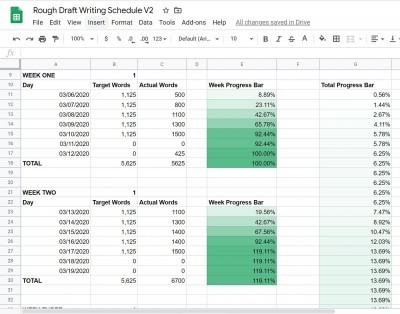
Create a schedule and stick to it. Google Sheets can help with this!
Perhaps the most important thing to do if you want to actually finish your book is establishing a schedule and keeping to it. Set a minimum daily word count and number of days per week that you plan to write. It’s best to start low here – say, 500 words per day, 5 days per week – and then increase these amounts over time as writing becomes a habit.
If you like using Google Sheets, you’re in luck. We’ve put together a writing schedule template where you input the total target word count, the number of weeks you want to spend writing, the number of days per week you expect to write, and the date you start writing. The template computes your daily target word counts and will show you a progress bar as you get closer and closer to finishing the book! Just make sure you’re signed in with a Google account, and you can use File -> Make a Copy to copy the template to your own account and start making edits.
If you’re dedicated to getting your book done within the 4 month timeframe defined in this guide, make sure your daily goal eventually gets high enough. For example, if your target word count is 80,000 words and you have 12 weeks to write, you need to produce just over 6,650 words per week. With a five-day workweek, that’s 1,330 words per day on average. If you start at a lower goal than that, you’ll eventually need to compensate by going over if you want to reach your goal.
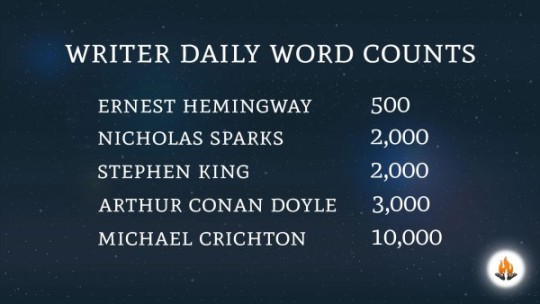
Your mileage may vary. Find a daily word count that works for you!
Just make sure you never go more than three days without working on your book, even if you only write a few hundred words. You’ll find that the story fades in your mind quite quickly if you don’t work on it for days on end. Keep the momentum going, and write as often as you can.
We have a lot more tips and tricks about this in our blog post Start Writing Strategically.
Stay Organized
Remember the organizational system we said you should make sure to have? Make sure you keep it up to date as you write. For Pantsers, you’ll thank yourself later when you’re writing chapter 38 and don’t have to sift through pages and pages just to find a character’s last name. Plotters, though you may have a lot of that information already nicely organized, your manuscript will almost certainly change course at least a little bit from the original plan. When it does, update your plan, or you’ll find yourself having the same issue of losing track of all those little details.
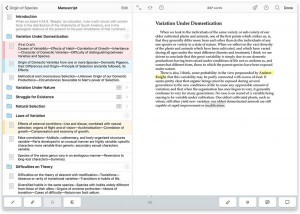
Keep your manuscript organized as you write.
When it comes to your manuscript, make sure you use headings or sections to break up the document into its chapters. That will allow for easy navigation between the different chapters, and will keep you grounded. Never get lost in your own book!
Conclusion
Hopefully this post has done its job, and you’re now a confident writer with a concrete plan to write a book from scratch. You’re about to open a new tab in your browser and search for the organizational system that’s right for you. Then you’ll pick the right manuscript editor and develop your story seed. If you’re a Plotter, you’ll add more detail to your characters, plot, and world until the story is broken up neatly into chapters, with each one moving the story along.
Finally, you’ll write the darn thing, and with some luck – publish it.
See you in four months.
Weekly TL;DR: Get organized, plan, and write your rough draft in four months using this practical guide. Don’t forget to use our writing schedule template.
If you have any questions or comments, join the discussion on our Discord!
#writing#writeblr#writingtips#writingadvice#writers#writblr#CampfireTechnology#campfirepro#campfireblaze#writingcommunity#howtowrite#writeabook#nanowrimo
3 notes
·
View notes
Video
youtube
Write Strategically - How to Make Writing a Habit
#writingtips#writingadvice#writingcommunity#writing advice#writeradvice#CampfirePro#CampfireBlaze#howtobeawriter#writer#writing#maketimeforwriting#nobutseriouslybekindtoyourselfyoucan'tdoamillionthingsinonedayandthenbeatyourselfupbecauseyourwordcountisnthighenough
0 notes
Video
tumblr
Sometimes writing encouragement is the LAST thing you need when writing a story.
#writingencouragement#writingpositivity#writing#writeblr#writers#writblr#writersontumblr#writer problems#fanfic writers#fanfic writer problems#fanfiction writers#beingniceandtellingwritersnicethingsallthetimeisharmfulnothelpful
0 notes
Video
tumblr
brains can be mean sometimes!! learn how to make your writer brain work FOR you instead of AGAINST you with the chemicals in your brain instead of the chemicals in your coffee cup
#writing#writeblr#writers#writing memes#writers on tumblr#writblr#writer problems#writing advice#writing tips#just writing things#just writing stuff#just writer things#just writer stuff#fanfic writers#fanfic writer problems#fanfiction writers#helpiamnewtotumblr#ifeellikeaboomerhowdoesthisevenwork#heyanybodywannagetasandwichlatertoday
0 notes
Photo
Sounds like George Orwell and Stephen King would have been great friends!







Hello dark academia lovers! I’m starting a new series on my instagram about writing tips from the masters and I picked George Orwell! If you’d like to see more of this, please check my instagram here: @labohemejulia. Thank you :)
1K notes
·
View notes
Video
tumblr
How to start writing strategically
#writeblr#writing#writinghelp#writingadvice#writingtips#writingcommunity#startwritingstrategically#trickyourbrainintowriting#CampfireYouTubeVideo#CampfirePro#CampfireBlaze#campfiretechnology#howtostartwritingabook#howtowriteabook
0 notes
Text
Start Writing Strategically
It is no secret that writing regularly is the key to becoming a great writer. We have been told over and over again that we need to write x-amount of words a day or free-write for y-amount of time. These are certainly useful tactics but can be hard to keep up. Maybe you’ve tried these before and stopped after not making the progress you wanted. That doesn’t mean you are a bad writer or lazy. It just means that you’re in need of some strategy and structure.
If you’d rather watch a video than read a blog, check out our video on the same topic here.
Part of establishing this new writing habit involves some psychological trickery. We are intelligent human beings, but we are also animals. There is the logical part of our brain that says things like “I should go to bed before midnight” and “I should eat fewer french fries.” But there is also the primitive part that only cares about food, water, and reproduction.
We need to be very aware of this part of ourselves. We constantly have a voice inside our heads that is looking for immediate gratification, and sadly writing doesn’t always provide that. Our goal is to combat that part of ourselves in a way that establishes a permanent and beneficial new routine.
This means we will need to address how we form new habits. Humans are incredibly habitual. Our brains reward us for doing things on a regular basis, which can work to our benefit and to our detriment. If you decide you want to start writing and just do it whenever inspiration strikes, you are setting yourself up for failure. Find time to regularly write. I know that’s easier said than done, but there are ways to help you establish a new routine.
Finding Time
Often when we start something new, we just find a time in our schedule and throw it wherever it fits best, but we don’t pay attention to an important question: What were we doing with that time before? Podcaster and Youtuber CGP Grey has a great theory on this. He says that to effectively establish a new habit, we need to be time neutral. When we add new things to our schedule, we need to take equivalent things out. Otherwise, we will tend to revert to whatever filled that space before.

Maybe you have a lot of free time and think this won’t be an issue for you, but we still fill our free time in habitual ways. No matter what our schedule looks like, something will likely have to go. We need to be careful about what we choose, though. Some habits are stronger than others, and it may be easier and more effective to remove one rather than another. We must remain aware of the primitive beast that lurks within.
Here’s a personal example: When I was in college, I wanted to start working out. I tried to start multiple times, to no avail. I would go whenever it worked for my schedule and never established a consistent workout routine. After a couple years of false starts, I came across CGP Grey’s theory. I looked at my schedule and saw how full it was. Classes, internships, homework, and media production filled almost every moment of every day.
I realized that if I wanted to get serious about working out, something had to go. I was working morning radio at my university’s student station, and I decided my time was up there. I quit the station and decided that early mornings were for the gym. I was able to make a time neutral change to my schedule, and I was actually able to keep with it!
Address Roadblocks
It will no doubt take some experimenting to establish a new schedule. We all have different inclinations and habits, and we may need to play around and see what works. It is important to record what does and doesn’t work. If we stay aware of the things that keep us from writing, then we can plan for them and adjust accordingly.

Identify the things that we think will help us maintain the habit and the things that hold us back. As we start to see these tendencies play out over and over again then we can really start to address them.
To continue my example from earlier: I actually didn’t just start working out regularly right out of the gate. I fell into the trap that many people fall into when it comes to exercise. Day one, I hit it hard then woke up the next day super sore and didn’t go back. This caused a few more false starts and the ever-familiar “I’ll try again next week.” I would get upset at myself for not working through the soreness which would lead to self-doubt about the whole situation.
Eventually, I came up with a new plan: start small. I decided not to work out so much that I got sore, because I knew I wouldn’t go to the gym the next day if I did. That was when I actually started hitting the gym on a regular basis, and I was able to slowly build up to where I wanted to be. I identified the things that kept me from what I wanted to do and addressed them.
In terms of writing, I know that my phone has often been an issue. It is a grand distraction. Every little notification has the ability to completely derail me. Step 1 for me was putting it on do not disturb mode, and while that helped, it didn’t completely resolve my issues. I would still instinctually pick up my phone and start scrolling through some app designed to steal my attention. So I downloaded an app designed to block distracting apps during my writing time.
That helped a lot. Sometimes I still find myself still disabling that app and scrolling anyway, but at this point, if I am having a particularly hard time with my phone, I just put it in the other room. Even small things like that can help us stay consistent and effective.
An important thing to address here is the feeling of self-doubt caused by failure to stick to our new habit. It is inevitable, and we all feel it. It is hard to distance our self-worth from our failures, but if we stay aware of what caused us to fail, then we haven’t failed at all. We’ve learned. In the words of Adam Savage, “Failure is always an option.” Establishing a new habit is incredibly difficult, and just because you’ve been unsuccessful in the past doesn’t mean you always will be. Take those failed attempts, see what caused them, and then address it.
Goals
Our brains love to hit goals. When we hit a goal we’ve set, our brain will reward us for it in the form of chemicals. As we associate these chemical hits with a certain task, we will be more likely to do a task again. When we eat food with a lot of sugar, our brains reward us with dopamine, so we tend to really like sugar!

If you start setting and reaching writing goals, you can trick your brain to reward you for writing. This helps change your habit from something that your logical brain wants into something that the primitive brain also craves. Turn writing into sugar!
As with anything else, we need to be strategic. People like Stephen King will tell you “write 1000 words a day,” but you might be setting yourself up for failure if that’s where you start. Start with something manageable and stick to it. Writing 1000 words a day will no doubt help you become a better writer, but not if you aren’t able to do it consistently. When it comes to setting goals, it’s important to be somewhat conservative.
If you set goals that you aren’t likely to accomplish, you will experience the opposite of the desired effect. Your brain will start to associate the failure of not hitting goals with writing and will be dis-incentivized from doing it. We need to set attainable goals and increase them over time. Then we can work our way to 1000 words a day or whatever your daily goal is.
Starting writing can be incredibly hard. It isn’t as easy as “just doing it.” Once we become conscious of the things that hold us back, we can really start to hone our craft. Having a consistent writing plan will provide a path for you to improve. Obviously, there are other things we can do along the way to help we’ll address in future blog posts, but the first step is starting.
Don’t forget to put your plan in action with our Let’s Find Time worksheet. If you have any questions or comments, join the discussion on our Discord! For more writing advice, check out our YouTube videos on the Campfire Technology YouTube Channel.
#writing#writingadvice#writinghelp#writingtips#writeblr#writingcommunity#campfireblaze#campfirepro#howtowrite#authorsoftumblr#author#writer#writersoftumblr#writers#writblr#writing encouragement#writingworkflow#start writing#howtowriteabook
1 note
·
View note